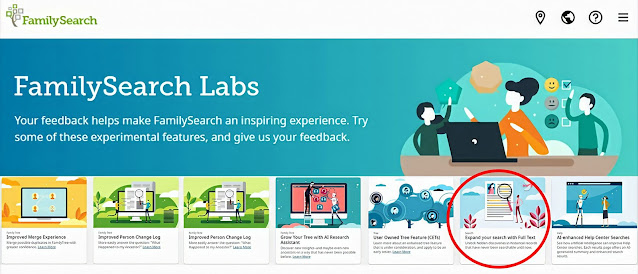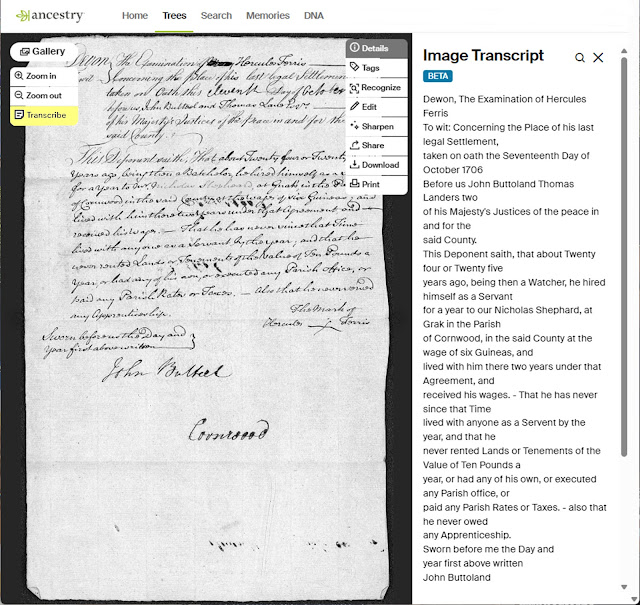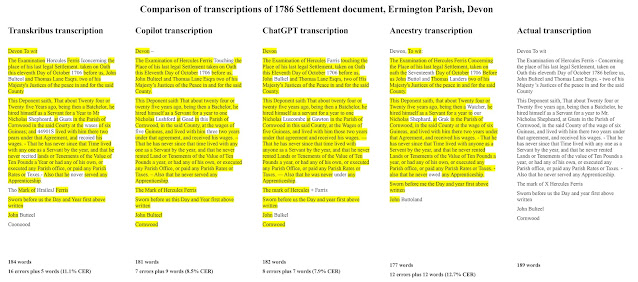I wrote about FamilySearch’s Full-Text Search module on 15 July 2025 (FamilySearch Full-Text Search ... and other AI processes for reading old handwritten documents). In that post I described how FamilySearch is making major inroads to viewing old documents, providing valuable transcriptions of them, and expanding the abilities of family historians to find elusive ancestors. At that point the technique was still in the testing stage, part of a group of experimental programs.
Well, Full-Text Search has now gone mainstream. Searching scanned documents in their library for names and keywords for almost any subject is now a main category under the Search menu on the FamilySearch home webpage. To use the almost limitless capabilities of the FamilySearch resources you only need to register a free account.
Hundreds of thousands of records from over 4,300 collections
have been added to the inventory of searchable documents with more coming
online regularly. Most importantly, non-indexed names and words can now be
found, a major advancement in the hunt for family information.
Since I wrote my last blog post, I have wanted to do a bit more detailed looking at possible records of interest. This time I went looking for all mentions of our surname “shepheard” from the main home page search menu.
In all categories and in all places worldwide, the total hits for the name were 36,999. Most (19,158) were in records from the United Kingdom and Ireland with a close second for USA records (16,129). The other 1,712 references were from Africa (30), Asia & Middle East (3), Australia & New Zealand (1,192), Canada (446), Caribbean & Central America (15), Continental Europe (12), South America (2 and Other (24).
I selected the UK & Ireland regions, moved down to England (16,790 hits) and then down to Devon (3,203). That is the area where most of my Shepheard family originated. I could have further narrowed down the review in various specific Collections (15 of them), Centuries (1500 to 1900) and Record Types (59). These are summarized below.
Vital records, that is birth/baptism, marriage and death/burial entries, represent the largest proportion, as might be expected (2,212 hits, 69%). These are records that are most likely to be indexed.
Shepheard appears in records from 79 Devon parishes, most in
the southern part of the county. Again, this would have been predicted as that
is the region where the Shepheard families were most prevalent.
The images presented are of very good quality, many much
better than the copies I obtained over the past few years from other sources.
There are a few inconsistencies in the transcriptions as one might expect using
old document. Some of the hits are different pages of the same collection but
that does not dimmish their importance.
Restricting my search to a specific spelling, of course,
meant that I missed seeing many individuals, but that can easily be remedied by
doing more broadly defined searches. For different spellings one can substitute
a ? for a letter.
So, a search for “sheph?rd” resulted in 2,216,970
hits (UK & Ireland = 285,409; USA = 1,806,249; England = 256,779; Devon =
12,927). And another search for “shep??rd” got 3,261,473 hits (UK &
Ireland = 389,635; USA = 2,643,351; England = 344,944; Devon = 15,980). Both
identified a much greater number of individuals in the primary regions of
Devon.
The results of just this basic search for potential family
members could lead to months if not years of work to review all the documents
and look for possible relationships. Full-Test Search is truly a game
changer.
And after my Shepheard ancestors I can look for other lines.
For example, a search for Mayfield had 544,125 hits (UK & Ireland = 15,579;
USA = 519,062; Maryland = 2,231; Baltimore = 729; 1800s = 301). This was the
name of one of my 3rd great-grandfather, who was born in England in
1778 and migrated to the USA around 1810.
Obviously, there is an infinite number of searches that
could be done which could add interesting and valuable information to my whole family
tree.
Following is a summary of the 3,203 Shepheard search results
for Devon in terms of numbers by area, collections, centuries and record types:
Full-Text Filtered Search Results (3,203)
Place: Devon, England, United Kingdom and Ireland
Collections (15)
England, Devon, Employment, from 1741
to 1838 (29)
England, Devon, Legal, from 1300 to
1600 (23)
England, Devon, Properties, 1745 (25)
United Kingdom, Biographies, from
1963 to 2009 (1)
United Kingdom, England, Biographies,
from 1860 to 1884 (15)
United Kingdom, England, Deaths, from
29 September 1589 to 9 April 1877 (753)
United Kingdom, England, Education,
from 1828 to 1839 (110)
United Kingdom, England, Employment,
from 1753 to 1795 (73)
United Kingdom, England, Legal, from
28 March 1842 to 25 March 1845 (1,545)
United Kingdom, England, Marriages,
from 1813 to 1868 (534)
United Kingdom, England, Others, from
1780 to 1933 (22)
United Kingdom, England, Poor Relief,
from 1 March 1874 to 31 March 1874 (118)
United Kingdom, England, Properties,
from 1628 to 1677 (200)
United Kingdom, England, Religious,
from 12 April 1762 to 5 April 1863 (1,021)
United Kingdom, England, Residences, 1905 (9)
Totals by Century
1500s (2)
1600s (110)
1700s (535) 16.7%
1800s (1,592) 49.7%
1900s (221) 6.9%
Record Types (59)
Vital Records, Death Records, Burial
Records (706)
Religious Records, Baptism Records
(629)
Vital Records, Marriage Records (528)
Voting Records, Voting Registers
(492)
Legal Records, Property Records, Land
Estate Records, Land Estate Tax Records (438)
Religious Records, Parish Records
(292)
Government Records, Tax Records, Tax
Assessment Records (175)
Legal Records, Court Records (128)
Legal Records, Court Records, Probate
Records (125)
School Records, School Enrollment
Records, School Admission Registers (110)
Legal Records, Property Records, Rent
Records (104)
Religious Records, Churchwarden
Records (97)
Legal Records, Property Records, Land
Records (86)
Religious Records, Poor Rate Records
(86)
Government Records, Tax Records, Rate
Books (56)
Business Records, Sale Records (44)
Government Records, Overseer Records
(44)
Government Records, Overseer Records,
Overseer Accounts (40)
Business Records, Employment Records,
Personnel Files (39)
Legal Records, Court Records, Court
Orders (33)
Vital Records, Death Records,
Cemetery Records, Burial Registers (31)
Legal Records, Property Records (30)
Business Records (17)
Reference Materials, History Records
(16)
Government Records, Public Records
(16)
Government Records, Poor Law Records,
Almshouse Records (9)
Religious Records, Poor House Records
(9)
Reference Materials, Historical
Geographies (8)
Vital Records, Death Records (7)
Vital Records, Death Records,
Cemetery Records, Gravestone Transcription Records (7)
Genealogies (7)
Religious Records, Poor Relief
Records (7)
Miscellaneous Records, Society
Records (7)
Periodicals, Directories (6)
Legal Records, Property Records, Land
Records, Land Assessment Records (6)
Business Records, Occupation Records
(6)
Government Records, Poor Law Records,
Poor Law Settlement Records (6)
Religious Records, Religious Marriage
Records (6)
Religious Records, Baptism Records,
Christening Records (4)
Government Records, Oath Rolls (4)
Government Records, Tax Records,
Valuation Records (4)
Religious Records, Bishop Transcript
Records (3)
Periodicals, Directories, City
Directories (3)
Legal Records, Property Records, Land
Records, Freeholder Records (3)
Genealogies, Heraldry Records (2)
Miscellaneous Records (2)
Legal Records, Court Records,
Property Settlement Records (2)
Legal Records, Court Records,
Bastardy Records, Bastardy Declarations (2)
Government Records, Nobility Records
(2)
Voting Records, Voter Lists (2)
Vital Records, Death Records,
Cemetery Records (1)
Vital Records, Death Records,
Cemetery Records, Grave Registers (1)
Genealogies, Family Histories, Family
History Record Indexes (1)
Legal Records, Court Records, Probate
Records, Probate Indexes (1)
Government Records, Poor Law Records,
Parish Poor Law Records (1)
Government Records, Town Records (1)
Government Records, Poor Law Records
(1)
Reference Materials (1)














